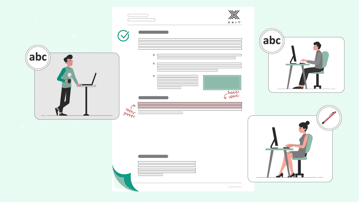It matters across industries—whether it’s tenders in energy, compliance reports in finance, regulatory filings in pharmaceuticals, contracts in government, or construction bids.
For elite teams, it’s the difference between falling behind and leading the field. By mastering each stage—planning, technical writing, reviewing, proofreading and editing, and publishing—they turn complexity into clarity and deliver documentation that regulators, evaluators, and stakeholders can trust.
The Document Development Lifecycle (DDLC)
Every complex document follows a clear document development lifecycle (DDLC). This step-by-step approach gives structure and predictability to work that often involves many contributors. The key stages are:
- Plan – Define objectives, compliance requirements, and the target audience.
- Structure – Use templates to outline sections and metadata.
- Draft – Bring in technical writers, content developers, and subject matter experts.
- Review – Validate accuracy, compliance, and clarity.
- Edit – Final proofreading and editing to make the text clear and easy to understand.
- Approve and publish – Secure sign-off with full accountability.
- Reuse – Store approved content in a library for future projects.
Why Traditional Document Development Breaks Down
In many organizations, the lifecycle is followed in theory but not supported in practice. Drafts are scattered across folders, feedback comes through long email chains, and formatting is patched together at the very end. This might work for short internal memos, but once the project grows into a tender, a regulatory submission, or a multi-author technical report, cracks appear.
The most common issues are:
- Version chaos with no clear “final” draft.
- Manual formatting that wastes time on layout, numbering, and style.
- Scattered reviews with feedback buried in inboxes.
- Content duplication where teams rewrite the same material again and again.
- Inconsistent outputs that weaken both credibility and the overall user experience.
These challenges slow down the review process, frustrate contributors, and increase compliance risks.
The Hidden Cost of Old Habits
The impact of inefficiency goes beyond frustration. Deadlines slip when reviews stretch too long, errors creep in that compromise accuracy, and regulators push back when documentation requirements aren’t met.
In competitive tenders, the result can be lost contracts when submissions fail to align with evaluation criteria. In industries where timing and compliance are critical, clinging to old methods isn’t just inconvenient—it can be damaging.
How Industry Leaders in Energy Master the Document Development Process
Some industries face particularly high stakes. In energy, for example, deadlines are strict, compliance rules are tough, and dozens of stakeholders must contribute to the same document. Leaders in these sectors don’t rely on email threads and disconnected files. Instead, they have redefined how they manage the document development process.
Their approach centers on modern co-authoring tools that bring the entire document production into one secure workspace. The benefits include:
- A single document as the source of truth, removing version chaos.
- Templates and automated layout that enforce consistency and compliance.
- Real-time collaboration so teams work together without conflict.
- Content libraries that store approved text, tables, and diagrams for reuse.
- Integrated review and approval workflows that provide traceability.
This allows them to deliver tenders, regulatory filings, and technical studies faster—without sacrificing accuracy or quality.
Modern Tools
Collaborative authoring software simplifies complex tasks. It provides a structured process for reliable teamwork. It includes version control and automated formatting. This helps projects run smoothly and grow easily.
- Collaboration: Multiple contributors—from subject matter experts to managers—work in parallel instead of passing drafts back and forth.
- Review and approval: Built-in workflows ensure feedback is captured in one place, versions are controlled, and approvals are recorded with full accountability.
- Content libraries: Approved sections can be stored once and reused across future projects, saving time and keeping information consistent.
- Templates and automated layout: Formatting, numbering, and branding are handled automatically, so experts can focus on substance instead of style.
- Proofreading and editing: With structure in place, editing becomes faster and more reliable.
By combining these elements, modern software and methods transform document development from a fragile process into a controlled, scalable system.
AI in the Document Development Process
Artificial intelligence is adding another layer of efficiency. Instead of replacing human expertise, AI supports document development by suggesting improvements during drafting, surfacing relevant content from past projects, flagging inconsistencies in reviews, and speeding up editing.
Some tools now include AI trained on safe company data. Unlike generic generative AI, these systems reuse compliant, approved content, keep outputs consistent, and reduce risk.
For example, in tender writing, AI can recommend text from earlier successful submissions, helping teams deliver with great speed, consistency, and compliance. The same applies to technical reports, regulatory filings, and field development plans.
One can also use generative AI more broadly as inspiration or support—for brainstorming structure, rephrasing sections, or suggesting alternatives. While this type of AI should not be relied on for compliance or accuracy, it can still act as a creative aid alongside more specialized, company-trained systems.









